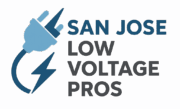What Types of Equipment Use Low Voltage? A Complete Guide
If you’ve ever wondered what types of equipment use low voltage, the answer might surprise you. Low voltage systems are everywhere — from your home lighting to commercial security networks. They power essential technology safely and efficiently, often saving energy and reducing the risk of electrical hazards.
Whether you’re setting up a new building or upgrading your current wiring, understanding how low voltage works and what devices rely on it can help you design a smarter, more reliable electrical system. Our team of low voltage installation experts in San Jose provides reliable solutions for residential and commercial systems.
What Does “Low Voltage” Mean?
“Low voltage” refers to electrical systems that operate at 50 volts (V) or less, though in most residential and commercial settings, this usually means 12V, 24V, or 48V power. Unlike standard 120V or 240V electrical wiring, low voltage circuits carry smaller currents — making them safer, easier to maintain, and ideal for sensitive electronic devices.
These systems often rely on transformers or power supplies that reduce standard line voltage to the lower levels needed by connected devices.
Common Types of Low Voltage Equipment
Low voltage wiring powers a wide variety of equipment across homes, businesses, and industrial facilities. Here are the most common categories:
1. Security and Surveillance Systems
- CCTV cameras
- Video doorbells
- Alarm systems
- Access control systems
Most security systems use 12V DC or PoE (Power over Ethernet) connections. This allows cameras and sensors to stay online safely without the need for high-voltage wiring.
2. Smart Home and Automation Devices
- Smart thermostats
- Lighting control panels
- Smart locks
- Home assistants and hubs
These systems use low voltage to communicate between devices while consuming minimal power — perfect for home automation and energy efficiency.
3. Networking and Communication Equipment
- Routers and switches
- Wi-Fi access points
- Intercom and PA systems
- Structured cabling systems (CAT6, fiber optic)
Low voltage cabling is the backbone of all modern communication systems, allowing data to move quickly and safely between computers, phones, and servers.
4. Audio and Visual Systems
- Speakers and amplifiers
- Home theater components
- Conference room AV systems
- Digital signage displays
Audio-visual setups rely on low voltage wiring for sound quality and reliable performance, especially in commercial spaces like offices, hotels, and restaurants.
5. Lighting and Landscape Systems
- LED strip lights
- Recessed lighting
- Outdoor and garden lighting
- Pathway and accent lights
Low voltage lighting (typically 12V) is one of the most common uses. It’s energy-efficient, safe to install, and perfect for both indoor and outdoor environments.
6. Building and Environmental Controls
- HVAC control panels
- Sensors (temperature, humidity, occupancy)
- Sprinkler and irrigation systems
These systems depend on low voltage signals to communicate data between sensors and controllers, helping maintain comfort and efficiency in large buildings.
Advantages of Low Voltage Equipment
Using low voltage systems offers several benefits for both residential and commercial environments:
- Safety: Reduces the risk of electrical shock and fire hazards.
- Energy Efficiency: Consumes less power, lowering utility costs.
- Versatility: Works for lighting, networking, audio, and control systems.
- Easy Maintenance: Cables and connectors are easier to repair or upgrade.
- Compatibility: Integrates with modern smart home and security devices.
Because low voltage wiring carries less electrical load, it can often be installed alongside existing high-voltage systems without heavy modifications — saving both time and money. Choosing the correct wire size is essential to ensure efficiency and safety. Learn more about what size wire is used for low voltage applications.
Low Voltage Equipment in Homes vs. Businesses
| Category | Residential Use | Commercial Use |
|---|---|---|
| Security | Doorbell cameras, motion sensors | CCTV, access control |
| Networking | Routers, smart TVs | Data racks, Ethernet drops |
| Lighting | Landscape, under-cabinet lights | LED panels, emergency lighting |
| Audio | Home theater speakers | PA and conference systems |
| HVAC | Smart thermostats | Building automation systems |
Professional Installation for Low Voltage Systems
While some low voltage equipment can be installed by homeowners, large-scale systems — especially in commercial or multi-unit buildings — require professional expertise.
Certified low voltage contractors in California can:
- Design and install structured cabling networks
- Integrate security and automation systems
- Ensure compliance with California Electrical Code (CEC)
- Provide testing and certification for reliability
Professional installation ensures that every component works together seamlessly, avoiding costly signal issues or interference later on. Proper connections depend on understanding wire roles. Find out what the common wire does in a low voltage system.
Upgrade to a Smarter, Safer Network
Low voltage systems power the future of technology — connecting everything from your Wi-Fi and lighting to your security and smart home controls. Whether you’re building a new property or updating an existing one, understanding what types of equipment use low voltage is the first step toward creating a modern, efficient, and secure environment.
For expert guidance and installation, reach out to a licensed low voltage contractor in California who can design a system that fits your exact needs.
